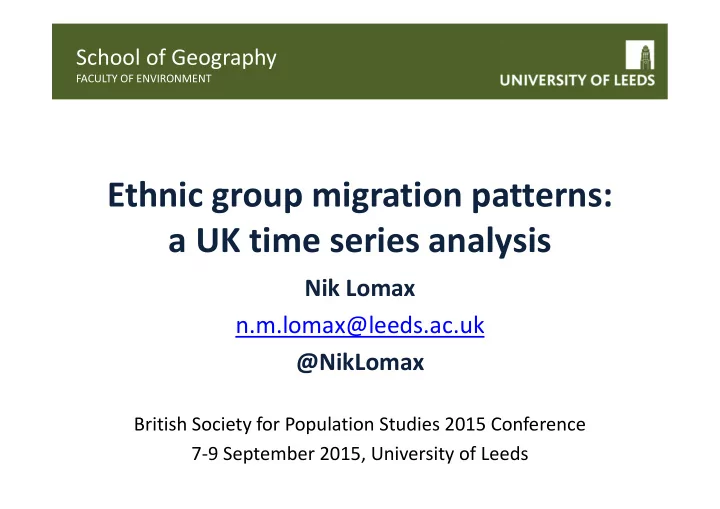

School of Geography FACULTY OF ENVIRONMENT Ethnic group migration patterns: a UK time series analysis Nik Lomax n.m.lomax@leeds.ac.uk @NikLomax British Society for Population Studies 2015 Conference 7-9 September 2015, University of Leeds
Outline 1. Ethnic group population projections – ETHPOP 2. Internal migration component methodology 3. Interaction patterns
2001 2011
2011 Rather than “Diversity Explosion” as seen in the USA (Frey 2015), are we seeing “Diversity Diffusion”? By 2051… wait for Phil Rees’ Presentation later in this session Note: Index of Diversity = 1 - e r e 2 where r e = proportion of the population in ethnic group e
Levels of migration (Migrants aged over 1) 2001 2011 Change % Change Inter-LAD 2,616,807 2,768,632 151,825 5.8 Intra-LAD 3,883,547 4,046,769 163,222 4.2 Immigrants 429,546 687,174 257,628 60.0 Total 6,929,900 7,502,575 572,675 8.3 There is a negative correlation between immigration and net out-migration of the 404 Local Authority Districts for each year of the time series: r = -0.67 in 2001/02, r = -0.74 in 2006/07 and r = -0.66 in 2010/11, all p<0.01.
Levels of migration (Migrants aged over 1) 9.6% non-white 17.8% non-white 2001 2011 Change % Change Inter-LAD 2,616,807 2,768,632 151,825 5.8 Intra-LAD 3,883,547 4,046,769 163,222 4.2 Immigrants 429,546 687,174 257,628 60.0 Total 6,929,900 7,502,575 572,675 8.3 There is a negative correlation between immigration and net out-migration of the 404 Local Authority Districts for each year of the time series: r = -0.67 in 2001/02, r = -0.74 in 2006/07 and r = -0.66 in 2010/11, all p<0.01.
Black Caribbean White British MEi = Indian Mixed
Evaluation, Revision and Extension of Ethnic Population Projections - ETHPOP • Our overall aim is to understand and to forecast the ethnic transition of the United Kingdom’s population • This is important for monitoring ethnic advantage / disadvantage & segregation • The team are Phil Rees (PI), Paul Norman, Pia Wohland, Nik Lomax & Stephen Clark
Evaluation, Revision and Extension of Ethnic Population Projections - ETHPOP • The migration component requires input time-series data of migration of ethnic group populations • Moving to a multi-regional model over a bi- regional model • Experimenting with probabilistic estimates which require good time-series estimates
Model Input: Origin-Destination-Age- Sex-Ethnicity Migration per 1,000 people White 500 450 Multiple ethnic group 400 Indian 350 Pakistani 300 250 Bangladeshi 200 Chinese 150 Other Asian 100 50 Black 0 Other Ethnic Group Source: 2011 Census table UKMIG003
Model Input: Origin-Destination-Age- Sex-Ethnicity Migration per 1,000 people 400 BAN BLA 350 BLC CHI 300 IND MIX 250 OAS 200 OBL OTH 150 PAK WBI 100 WHO 50 0 A0 A3 A6 A9 A12 A15 A18 A21 A24 A27 A30 A33 A36 A39 A42 A45 A48 A51 A54 A57 A60 A63 A66 A69 A72 A75+ Age Estimated from 2011 Census tables UKMIG003, MU01AUK_LA_All and MMo1_BUK_All
Model Input: Origin-Destination-Age- Sex-Ethnicity
Model Input: Origin-Destination-Age- Sex-Ethnicity Adapted from Rees and Willekens 1986
Model Input: Origin-Destination-Age- Sex-Ethnicity
Combining data and estimating gaps • Iterative Proportional Fitting
Metro and non-metro flows 100 7 7 7 7 8 10 11 11 13 13 15 90 26 18 18 20 22 23 80 23 23 24 24 23 28 70 % of all migration 24 18 26 21 24 60 26 25 22 21 50 24 25 22 40 26 30 54 52 52 49 44 43 43 43 20 38 37 37 23 10 0 WBI WHO MIX IND PAK BAN CHI OAS BLA BLC BLO OTH Ethnic group Metro-Metro Metro - Non-Metro Non-Metro - Metro Non-Metro - Non-Metro
Chinese and Chinese 16-24 Pakistani 16-24 Pakistani migration at age 16 to 24 500 450 Pakistani 400 Chinese 350 300 250 200 150 100 50 0
Moves within metro areas 60 50 20 15 40 15 % of all migration 18 15 15 13 15 12 30 13 13 23 19 24 20 20 15 19 18 16 9 12 19 15 10 10 13 11 11 10 9 9 9 8 8 8 6 3 0 WBI WHO MIX IND PAK BAN CHI OAS BLA BLC BLO OTH Ethnic group Core to Core Core to Rest Rest to Core Rest to Rest
Urban – Rural Patterns CHI WBI WHO Dense to Dense to Dense Sparse Sparse to Sparse to Dense Sparse BLA BLC PAK
Ethnic Concentration Chinese Indian Pakistani High to High High to High High to Low High to High High to Low High to Low Low to Low Low to High Low to Low Low to High Low to Low Low to High
Conclusions • Ethnic diversity in the UK has increased between 2001 and 2011 and is projected to increase further • Internal migration patterns by ethnic group an important component of population change – Age structure and migration rates vary by group • Need to get this right for our projection models • Further estimation required for the full Origin- Destination-Age-Sex-Ethnicity array • Full ODAS array allows us to experiment with multi-regional projection model
School of Geography FACULTY OF ENVIRONMENT Ethnic group migration patterns: a UK time series analysis Nik Lomax n.m.lomax@leeds.ac.uk @NikLomax www.ethpop.org
References Frey, B (2015) Diversity explosion: How new racial demographics are • remaking America. Washington: The Brookings Institution Lomax, N., Norman, P., Rees, P. and Stillwell, J. (2013) Subnational • migration in the United Kingdom: producing a consistent time series using a combination of available data and estimates. Journal of Population Research 30(3): 265-288. DOI 10.1007/s12546-013- 9115-z.http://link.springer.com/article/10.1007%2Fs12546-013- 9115-z Rees, P. and Willekens, F. (1986) Data and accounts. In Rogers, A. • and Willekens, F., eds. Migration and settlement: A multiregional comparative study. Dordrecht: Reidel, pp.19-58.
Recommend
More recommend